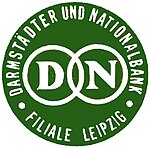Danat-Bank
 | |
 Head office at Schinkelplatz 1–4 in Berlin, photographed in 1931 (destroyed in World War II) | |
| Company type | Aktiengesellschaft |
|---|---|
| Industry | Banking |
| Predecessor | Bank für Handel und Industrie |
| Founded | 1922 |
| Defunct | 1931 |
| Successor | Dresdner Bank |
| Headquarters | |
The Darmstädter und Nationalbank, in shorthand Danat-Bank or Danatbank, was a large German joint-stock bank. It was formed in 1922 from the merger of the Bank für Handel und Industrie (Darmstadt), known as Darmstädter Bank, and the Nationalbank für Deutschland. Its failure in July 1931 was a significant episode of the European banking crisis of 1931.[1][2][3]
Overview[edit]



In 1920/1921, the Darmstädter Bank für Handel und Industrie and the Nationalbank für Deutschland formed the bank union Darmstädter-Nationalbank Berlin. Both banks assumed a joint guarantee of capital and reserves of over 1 billion marks. The merger was fully completed in 1922, resulting in one of the largest commercial banks in Germany.
By 1930, Danat-Bank had become Germany's second-largest joint-stock bank, with total deposits of 2.4 billion Reichsmarks ahead of Dresdner Bank (2.3 billion), Commerz- und Privatbank (1.5 billion), Reichs-Kredit-Gesellschaft (619 million), and Berliner Handels-Gesellschaft (412 million), and only behind Deutsche Bank & Disconto-Gesellschaft (4.8 billion).[4]: 354 In the European banking crisis of 1931, however, Danat-Bank suffered a run which started around 17 June due to rumours of the insolvency of the Norddeutsche Wollkämmerei & Kammgarnspinnerei (North German Wool and Worsted Yarn Spinning Works), finally going bankrupt on 13 July 1931. It was thus one of the most prominent victims of deflation in Germany during the Great Depression.
The collapse of Danatbank triggered a loss of confidence in the German banking system, and let loose a wave of withdrawals from all other banks beginning the German Banking Crisis. In reaction, the government announced a Bank Holiday starting on 13 July, imposed further capital controls and forced the merger of Danatbank with Dresdner Bank. [citation needed]
Key individuals[edit]
Well-known bankers of the Danatbank and its predecessors are (in alphabetical order):
- Siegmund Bodenheimer, Manager of Darmstädter Bank 1910–1922, shareholder 1922–1931
- Bernhard Dernburg, Manager of Darmstädter Bank 1901–1906
- Jakob Goldschmidt, Shareholder 1922–1931
- Johannes Kaempf, Branch director of the Bank für Handel und Industrie in Berlin and Reichstags-President
- Hjalmar Schacht, Shareholder 1922–1923
- Georg von Simson, Shareholder bis 1929
- Richard Witting, Director (1902–1910) and board member (1911–1922) of the Nationalbank, board member of Danatbank
References[edit]
- ^ Born, Karl Erich (1967). Die deutsche Bankenkrise 1931: Finanzen und Politik (in German). München: Piper.
- ^ Pohl, Manfred (1982). Konzentration im deutschen Bankwesen (1848–1980) (in German). Frankfurt am Main: Knapp. ISBN 978-3-7819-0269-5.
- ^ Isabel Schnabel (2004), "The German Twin Crisis of 1931", Journal of Economic History, 64:3 (3), Cambridge University Press, on behalf of the Economic History Association: 822–871, JSTOR 3874821
- ^ P. Barrett Whale (1930), Joint Stock Banking in Germany: A Study of the German Creditbanks Before and After the War (PDF)


 French
French Deutsch
Deutsch